|
|
|
Sort Order |
|
|
|
Items / Page
|
|
|
|
|
|
|
| Srl | Item |
| 1 |
ID:
102594
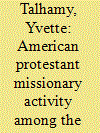

|
|
|
|
|
| Publication |
2011.
|
| Summary/Abstract |
During the 17th century Christian missionaries began to arrive to the region of the Ottoman Empire especially to Syria, Lebanon, and the Holy Land, in order to work among the Eastern Christians and among the Muslims, including the religious minorities such as the Druze and the Nusayris/?Alawis. Their main target was to convince them to convert. The American Protestant missionaries were the main missionaries who worked among the Nusayris. Due to their extreme beliefs, the Nusayris were mistreated by the Ottomans, and the region in which they resided was much neglected. The Protestant missionaries took advantage of this opportunity and began to build schools in the region so that Nusayri children could be taught the Bible and be induced to convert. The Ottomans grasped the danger of the missionary activity in the Empire and tried to win the Nusayris back by building schools and mosques to 'Sunnify' them. After 60 years of working amongst the Nusayris the success of the missionaries was very limited.
|
|
|
|
|
|
|
|
|
|
|
|
|
|
|
|
| 2 |
ID:
095481
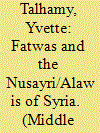

|
|
|
|
|
| Publication |
2010.
|
| Summary/Abstract |
There were five fatwas prior to the twentieth century which were issued by Sunni scholars. Some of these fatwas were specifically against the Nusayris/Alawis while others were against all the extreme Shi'ite creeds including the Nusayris. The first three fatwas were issued during the fourteenth century, during the period of Mamluk rule. They were issued by Shaykh al-Islam Taqi al-Din ibn Taymiyya, and were specifically directed against the Nusayris. The fourth fatwa was issued during the first years of the Ottoman rule over the region of Syria and was against all the extreme Shi'ite creeds. The fifth and last fatwa was issued by a local Shaykh of Latakia specifically against the Nusayris. Those fatwas viewed the Nusayris as heretics outside Islam. During the twentieth century, after the collapse of the Ottoman Empire, the region witnessed the ascendance of 'Pan Arabism', and it was during this period that the Nusayris, known now as Alawis, received a fatwa from the prominent Sunni mufti Hajj Amin al-Husayni recognizing them as part of the Muslim community, which helped them integrate into the Arab world and in Syria. In 1970, the Alawis, under the leadership of the Alawi Hafiz al-Asad, became the rulers of Syria. During the 1970s the Alawis were granted two additional fatwas, this time from prominent Shi'ite scholars recognizing them as part of the Shi'ite creed. All these fatwas had an enormous effect on shaping the history of the Nusayris.
|
|
|
|
|
|
|
|
|
|
|
|
|
|
|
|
| 3 |
ID:
115334
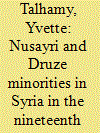

|
|
|
|
|
| Publication |
2012.
|
| Summary/Abstract |
In October 1831 Muhammad Ali Pasha's army under the command of his son, Ibrahim Pasha, attacked Greater Syria, where he faced little resistance. By May 1832 Muhammad Ali and the Sultan signed the K¨tahya peace treaty, and the region of Greater Syria became formally part of Muhammad Ali's domains, in which he decided to implement several reforms. One of these reforms was disarmament and conscription. As a result several revolts erupted in the region of Greater Syria; the two most important revolts were those of the Nusayris and the Druze, two heterodox religious minorities. The Nusayri revolt erupted in September 1834 and lasted for nine months until the rebels were fiercely subdued, disarmed and conscripted. After subduing the Nusayris in October 1835, the Egyptians conscripted the Druze of Mount Lebanon. Although the Druze resisted the orders, they lacked leadership and thus were easily disarmed and conscripted. The main revolt of the Druze was in November 1837 in the Hawran region, where the Druze put up a fierce fight against the Egyptians. Even though the Druze were subdued after almost nine months, they obtained a lenient agreement in which they were released from conscription and only partly disarmed.
|
|
|
|
|
|
|
|
|
|
|
|
|
|
|
|
| 4 |
ID:
084070
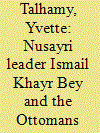

|
|
|
|
|
| Publication |
2008.
|
| Summary/Abstract |
Isma'il Khayr Bey was an outstanding chief of the Matawira Nusayri/'Alawi tribe which during a short time succeeded in controlling a large heterogeneously populated region and gained himself a prestigious title as 'governor of the mountain'. Though the Nusayris admired Isma'il for his courage they suffered from his oppressive rule. The local Muslim inhabitants of the mountain detested the fact that their governor was a Nusayri. The Ottomans were alarmed by Isma'il's growing status in the region and decided to put an end to his rule. The fact that Nusayri society lacked internal solidarity helped the Ottomans achieve their goal. Ultimately, Isma'il was killed by his own uncle.
|
|
|
|
|
|
|
|
|
|
|
|
|
|
|
|
| 5 |
ID:
092177
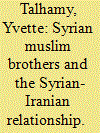

|
|
|
|
|
| Publication |
2009.
|
| Summary/Abstract |
The 'Alawis of Syria are part of the Shi'a stream; this has led to an alliance with Iran, the center of Shi'ite Islam. This alliance aggravated the oppositionist Syrian Muslim Brotherhood (MB), whose members have been in exile since 1982. According to them, the alliance is a stage in a Shi'ite scheme to take over the Sunni countries, including Syria. However, during the past year the MB has changed their strategy, and we are currently witnessing a rapprochement between the Brotherhood and Damascus.
|
|
|
|
|
|
|
|
|
|
|
|
|
|
|
|
|
|
|
|
|